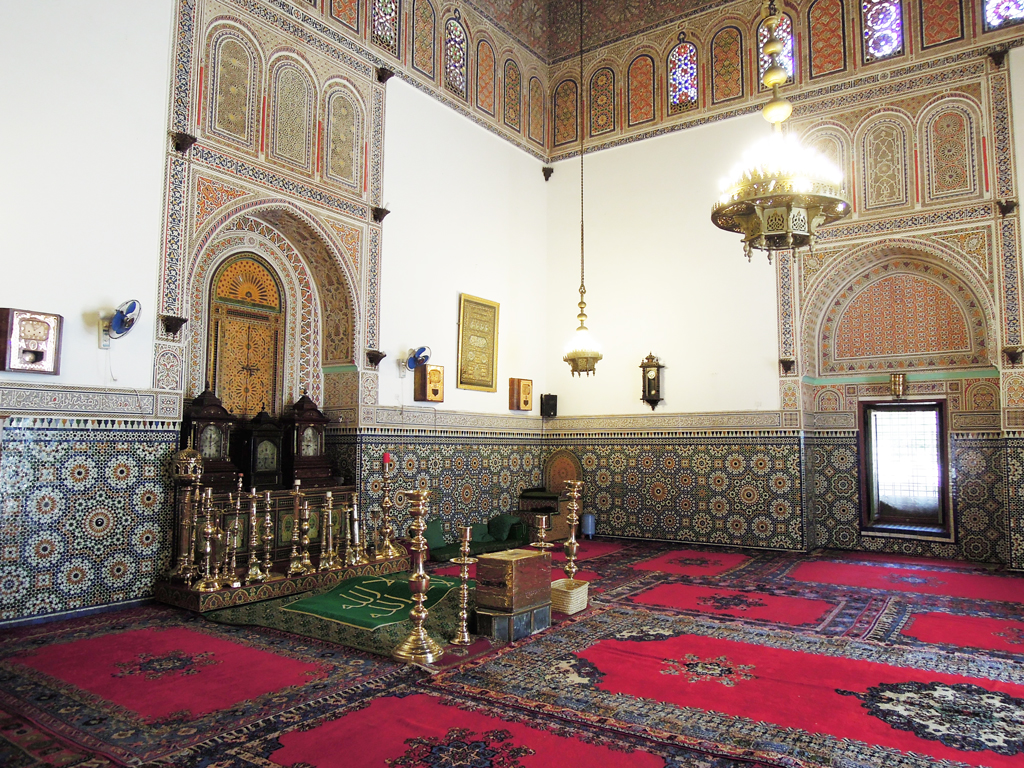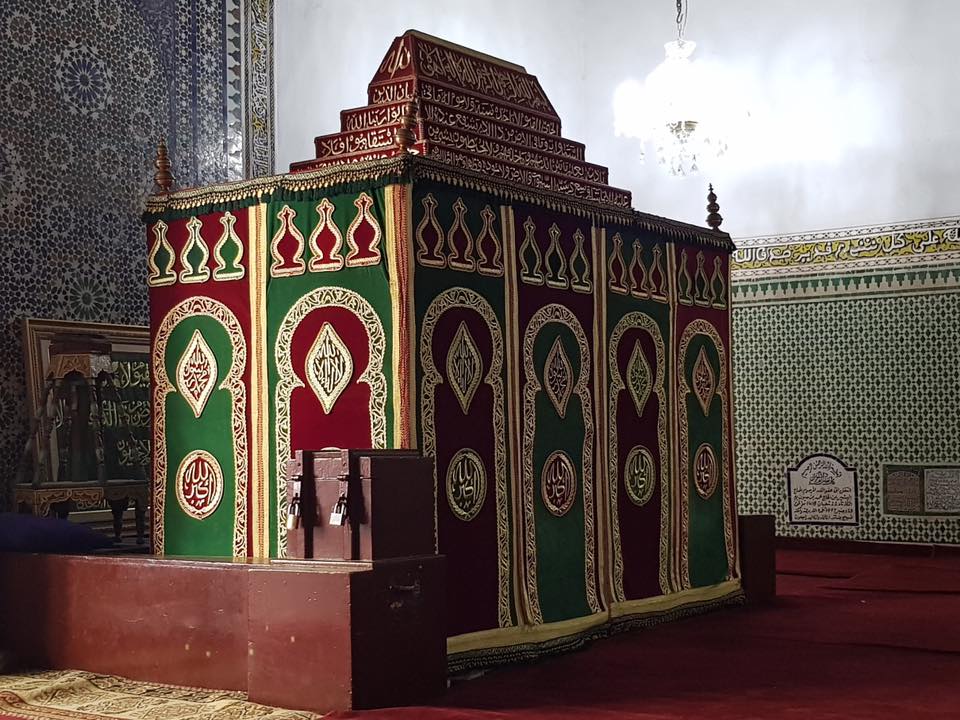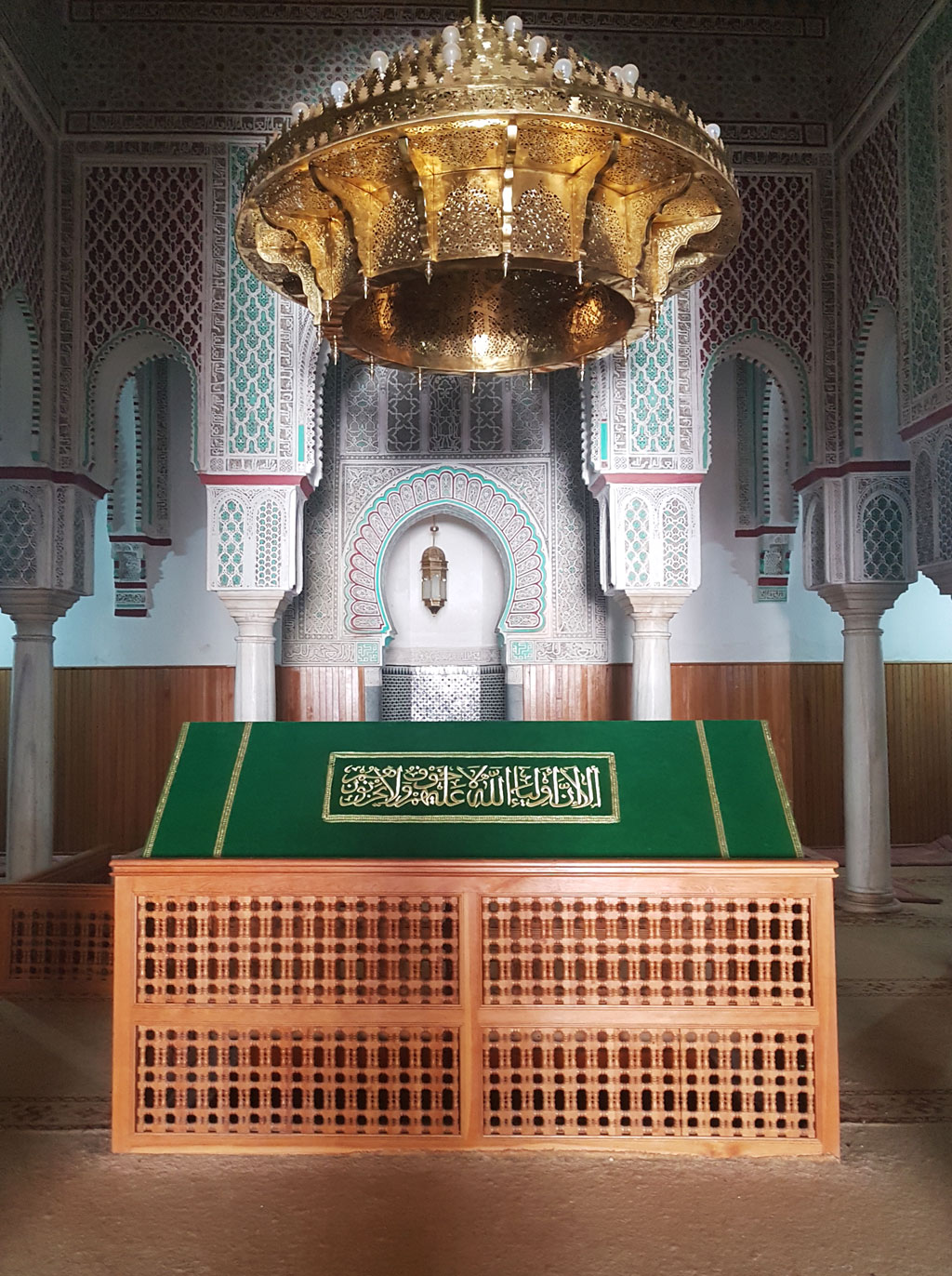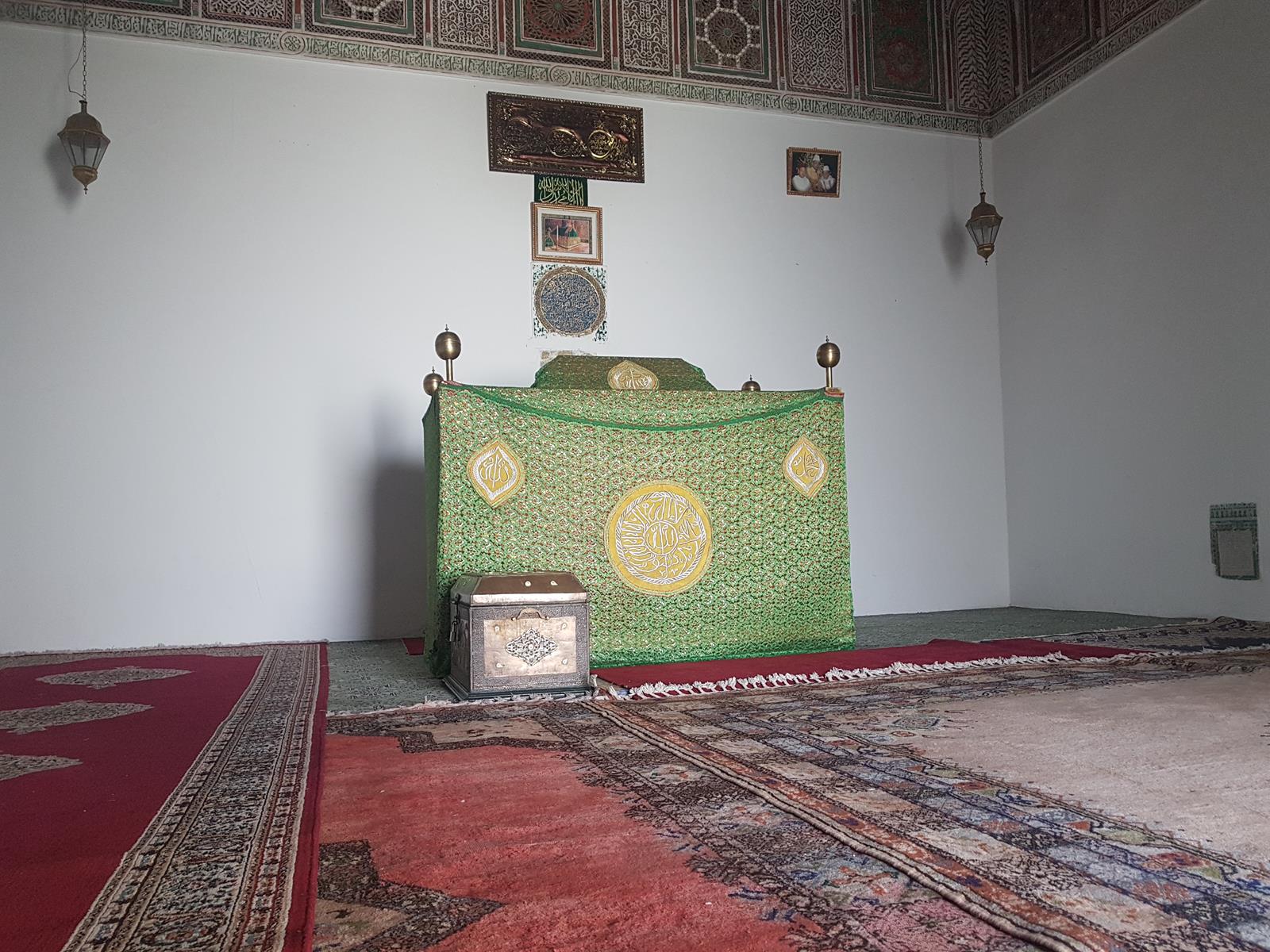
Among the Seven Saints of Marrakesh, none holds a more prominent place in the hearts of the city's inhabitants than Sidi Bel Abbas al-Sabti. Born Abu al-Abbas Ahmad ibn Ja'far al-Khazraji al-Sabti in Ceuta in 1129, this extraordinary scholar and mystic would transform the spiritual and social landscape of Marrakesh through a revolutionary philosophy centered on charity, compassion, and service to humanity. His zawiya remains the largest and most popular in the city to this day, a living testament to a life dedicated to alleviating the suffering of the poor and marginalized.
Sidi Bel Abbas traced his lineage to the illustrious tribe of al-Khazraj, one of the two main Arab tribes of Medina who supported the Prophet Muhammad upon his migration from Mecca. This noble Ansari heritage connected him directly to the earliest supporters of Islam, yet his early life was marked by poverty and hardship.
Born in the city of Ceuta (known in Arabic as Sabta, hence his name "al-Sabti") in 524 AH/1129 CE, young Ahmad lost his father at an early age. His mother, struggling to support her son, sent him to work as an apprentice to a weaver to learn the trade in exchange for wages. However, the boy showed little interest in the mechanical craft. Instead, he was irresistibly drawn to the circles of learning, repeatedly visiting the great scholar Abu Abd Allah Muhammad al-Fakhhar (buried in Tetouan) to acquire knowledge.
Abu Abd Allah al-Fakhhar, who would become Abu al-Abbas's primary teacher, was himself a student of the renowned Qadi 'Iyad, creating a direct chain of scholarly transmission from one of the greatest jurists of the age. Under al-Fakhhar's guidance, Abu al-Abbas received a comprehensive Islamic education, mastering jurisprudence according to the Maliki school, hadith sciences, and the broader Islamic intellectual tradition.
Ibn al-Muwaqqit al-Marrakushi, in his work "al-Sa'ada al-Abadiyya fi al-Ta'rif bi-Rijal al-Hadra al-Marrakushiyya" (Eternal Happiness in Introducing the Men of the Marrakeshi Presence), described him as "the proof of the Maghribis against the people of all regions," emphasizing his stature as a leading authority. He was noted as being "greatly versed in Islamic sciences, a jurist according to the school of Malik, possessing leadership in jurisprudence in his time, insightful regarding the subtleties of the school, disciplined in its principles, and knowledgeable in the craft of legal rulings."
In the year 540 AH/1144 CE, at the age of sixteen, Abu al-Abbas sought permission from his teacher to travel in pursuit of knowledge and to meet other spiritual masters. The timing of his departure was significant: the year following the victory of the Almohads over the Almoravids, particularly after the death of Tashfin ibn Ali ibn Yusuf in 539 AH/1144 CE. The young scholar chose Marrakesh as his destination, explaining that it was "a city of knowledge and righteousness," and more importantly, the capital of the emerging Almohad state.
The question naturally arises: why would Abu al-Abbas leave Ceuta, which was itself a major center of learning—the city of Qadi 'Iyad and his intellectual circle? Researcher Muhammad Rabitat al-Din, in his article "Abu al-Abbas al-Sabti and the Space of Marrakesh," suggests that there were deeper motivations at play, possibly connected to an organized Sufi movement that was beginning to emerge from under what he calls "Almoravid restrictions."
When Abu al-Abbas arrived in Marrakesh, he found the city under siege—a siege that would last from Muharram to Shawwal of 541 AH/1146 CE. Rather than entering the besieged city, he ascended Mount Gueliz (Jebel Gueliz) with his servant Mas'ud al-Hajj, where he would remain in spiritual retreat for an astonishing forty years.
The location of this retreat has been debated by scholars. While there is a mountain called Gueliz adjacent to present-day Marrakesh, some researchers argue that Abu al-Abbas actually retreated to another Mount Gueliz in the Hargha tribe region of the High Atlas Mountains. The argument for the latter location is compelling: the proximity of the Marrakesh Gueliz to the tumultuous conflict between the Almohads and Almoravids would have made it an unsafe place for contemplative retreat, while the High Atlas location would have provided the isolation necessary for worship.
According to traditional accounts, God caused a spring of water to flow for Abu al-Abbas on the mountain, and he devoted himself to worship and learning, with his servant faithfully attending to him. This period of seclusion coincided with significant political changes, including the arrival in Marrakesh of both Qadi 'Iyad and Imam al-Suhayli, though Abu al-Abbas remained in his mountain retreat.
The fact that the prominent Sufi Abd al-Jalil ibn Wayhallan, leader of the Sufis of Aghmat and Rika, also resolved to ascend to Mount Gueliz in the same year (541 AH) suggests, according to researchers, the existence of an organized Sufi movement that was strategically positioning itself during this transitional period from Almoravid to Almohad rule.
News of Abu al-Abbas's spiritual states and miracles eventually reached Sultan Ya'qub al-Mansur, the Almohad ruler known for his patronage of learning and the religious sciences. In the era of al-Mansur's reign, after forty years of solitary worship, the Sultan and the notables of Marrakesh ascended the mountain to seek blessings from Abu al-Abbas, and the Sultan invited him to descend and reside within the city walls.
Al-Mansur offered to provide Abu al-Abbas with a residence and a madrasa for teaching. The scholar accepted and settled in a lodging house known in historical sources as "Funduq Muqbil" in the Agadir quarter of Marrakesh. Some historians, including De Castries in his work "Les sept patrons de Marrakech," go so far as to suggest that Sultan Ya'qub al-Mansur became a follower of Abu al-Abbas, taking him as his spiritual guide after failing to meet the great mystic Abu Madyan al-Ghawth, who died in the village of al-'Ubbad near Tlemcen while en route to Marrakesh. The same Sultan is reported to have embraced asceticism later in life and entered the Sufi path.
This relationship exemplifies a new dynamic between political authority and Sufism that would characterize much of the Almohad period in Morocco, making this era a golden age for the flourishing of Islamic mysticism in the region.
The period following Abu al-Abbas's descent from the mountain proved to be the most productive phase of his life. It was during this time that he developed and spread his distinctive social philosophy, which was revolutionary in its scope and practical application. The place where he settled quickly transformed into a gathering point for the poor, the needy, orphans, and widows, and the surrounding area evolved into a humanitarian community built on alleviating poverty and combating deprivation according to a clearly defined social project.
The scholar Yusuf al-Talidi writes in his book "al-Mutrib fi Mashahir Awliya' al-Maghrib" (The Delightful Account of the Famous Saints of Morocco): "In the early days, he lived in the lodging house and taught students grammar and arithmetic, and whatever fees he received, he would spend on foreign students. He spent the rest of his time wandering through the markets, reminding people and commanding them to pray."
At the heart of Abu al-Abbas's teaching was a profound statement recorded by Ibn al-Zayat al-Tadili in his book "al-Tashawwuf": "The foundation of good in this world and the hereafter is charity (ihsan), and the foundation of evil is miserliness (bukhl)." This simple yet powerful principle became the cornerstone of a comprehensive social system built on giving.
Abu al-Abbas established a hierarchical framework for charity, identifying three ascending levels: first, sharing (mushatara); second, beneficence (ihsan); and third, gratitude for blessings (shukr al-ni'ma). His philosophy was so distinctive that the famous philosopher Ibn Rushd (Averroes), when he heard about Abu al-Abbas and learned the secrets of his approach, made his celebrated statement: "This is a man whose doctrine is: existence is moved by generosity" (al-wujud yanfa'il bi-al-jud).
Abu al-Abbas gave special importance to the science of arithmetic, ingeniously employing it in calculations related to the distribution of charity and zakat. Researchers Hamid al-Turiki and Halima Barakat, in their book "Abu al-Abbas al-Sabti: The Righteous Saint of Marrakesh," explain that he began with the tithe designated for obligatory zakat and developed a complex system that led him to distribute nine-tenths of his wealth and possessions to the poor and needy.
He integrated this practical mathematics into his teaching curriculum, linking the instruction of arithmetic with its application in charitable operations. According to the same researchers, "In parallel with spreading knowledge, he put himself at the service of his students, from whom he bore the heaviest burdens, and he took upon himself the support and meeting of the needs of the destitute and poor."
Abu al-Abbas developed what can be described as an "interpretive" or symbolic reading of Islamic rituals and practices, drawing out their inner meanings related to charity and generosity. He interpreted the testimony of faith (shahadatayn) as indicating that worldly wealth belongs to a Creator without partner who gives it to His servants so that they might relinquish a portion of it. He saw the raising of hands in the opening takbir of prayer as humanity's acknowledgment that they possess nothing and that all they have belongs to God. The bowing (ruku') signified sharing wealth with the poor. Zakat meant cultivating the habit of giving. The pilgrimage (hajj) represented divesting oneself of worldly possessions.
This methodology reveals a cosmological vision with philosophical dimensions, wherein Islamic worship is dialectically connected to practical meanings that give worship a universal, epistemological, and humanitarian significance.
Ibn al-Zayat al-Tadili recorded: "I attended his gathering several times and saw that his doctrine revolved around charity, and he would refer all matters of the Shari'a to it. When anyone came to him with any matter, he would command them to give charity and say: 'Give charity and everything you desire will happen for you.'"
Abu al-Abbas embodied the ethics he preached. Ibn al-Zayat described him as one who "was kind to those who harmed him and forbearing toward those who acted foolishly toward him, merciful, compassionate, beneficent to the poor, orphans, and widows. He would sit wherever he could in the markets and streets, urging people to give charity, and he would mention what came regarding its virtue from verses and prophetic traditions. Charitable donations would pour upon him, and he would distribute them to the poor and then depart."
His reputation for miracles and answered prayers spread throughout Marrakesh and beyond. His proximity to the Almohad court raised some eyebrows among contemporary scholars. Notably, Ibn al-Zayat al-Tadili concluded his famous work "al-Tashawwuf" with a special section titled "Reports about Abu al-Abbas al-Sabti," treating him differently from other Sufis and saints in the book. Some scholars have wondered whether this reflects Ibn al-Zayat's discomfort with Abu al-Abbas's closeness to political power, or whether it actually demonstrates recognition of his unique contribution to Marrakesh's society—significant enough to warrant special treatment even if placed outside the main text.
More than eight centuries after Abu al-Abbas's death, his teachings continue to shape daily life in Morocco through the practice of "al-'Abbasiyya." This tradition, intimately connected to his name, involves vendors of traditional foods giving away the first items they prepare each morning—whether pastries, bread, or sweets—as a form of charitable opening to the day. This practice serves as a daily commemoration of the saint who built his entire philosophy on generosity and giving, keeping his memory alive in the most practical and beautiful way.
The scholar Ahmad Baba al-Timbukti noted in his work "Nayl al-Ibtihaj bi-Tatriz al-Dibaj," written during the Sa'di period: "Even now, the situation remains as it was at his sanctuary, with crowds of people thronging to it and having their needs fulfilled, though that generosity has diminished due to the corruption of the times."
The historian Lisan al-Din ibn al-Khatib wrote about Abu al-Abbas: "Sidi Abu al-Abbas al-Sabti, may God be pleased with him, was sought after during his lifetime... His state was among the greatest signs that broke with custom, and the foundation of his matter was built upon the idea that the world is moved by generosity, which constitutes wisdom in affecting existence. He has widely circulated reports and dazzling examples in this regard."
Abu al-Abbas al-Sabti passed away on Monday, the 3rd of Jumada al-Akhira, 601 AH/1204 CE, and was buried in his zawiya, which has become one of the major pilgrimage sites in Marrakesh. He is the most famous of the city's Seven Saints without question.
Some historians hold that Abu al-Abbas was buried in the grave of the philosopher Ibn Rushd (Averroes), who had died in 595 AH/1198 CE and was initially buried in Marrakesh before his body was transported three months later to his native Cordoba in al-Andalus. The grave remained empty until Abu al-Abbas was interred there, and later his son Abdullah and his grandson Yahya were buried nearby, may God have mercy on them all.
In 1012 AH, Sultan Abu Faris Abd al-Aziz al-Sa'di built a grand mosque over the site. The shrine of Abu al-Abbas receives visitors in unprecedented numbers, especially on Wednesdays. The great scholar Ahmad Baba al-Timbukti mentioned in his book that he visited the shrine more than five hundred times, demonstrating the status of the 'Abbasi sanctuary among scholars, of whom Baba al-Timbukti was among the most distinguished.
Today, the zawiya of Sidi Bel Abbas remains the largest and most active in Marrakesh. It continues to fulfill the mission its founder established over eight centuries ago: serving the destitute and sick of the city. Unlike many historical sites that have become mere monuments, this zawiya pulses with life and activity. The poor and needy still gather there, and charitable works continue in the spirit of the saint who made generosity the foundation of his spiritual path.
Abu al-Abbas al-Sabti represents a unique synthesis of Islamic scholarship, mystical insight, and social activism. He was simultaneously a master jurist who attained leadership in Maliki jurisprudence, a profound mystic who spent forty years in retreat, and a social reformer who developed practical systems for wealth redistribution and poverty alleviation. His life demonstrates that Islamic spirituality, far from being divorced from worldly concerns, can provide the foundation for revolutionary social change.
As we walk through the streets of modern Marrakesh and observe vendors giving away their first sale of the day in al-'Abbasiyya, as we see visitors streaming to his zawiya, as we note the continued association of his name with charity and compassion, we recognize that Sidi Bel Abbas al-Sabti achieved something rare: he transformed not just individual hearts, but the very social fabric of a city, creating institutions and practices that have endured for centuries.
His philosophy—that existence is moved by generosity—remains as relevant today as it was in medieval Marrakesh. In an age often characterized by materialism and self-interest, the example of Abu al-Abbas reminds us that true wealth lies not in accumulation but in giving, not in keeping but in sharing, and that the highest form of worship is service to humanity.
May God sanctify his secret and grant us the love of His saints. Fatiha.










Find all our meditations on the Nur App!
Experience tranquillity through Qur'anic recitations and meditations on our Nur App and develop healthy spiritual routines to maintain your God-given Nur (light).
